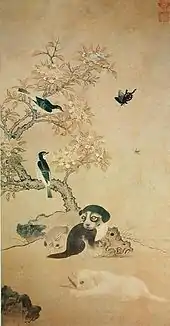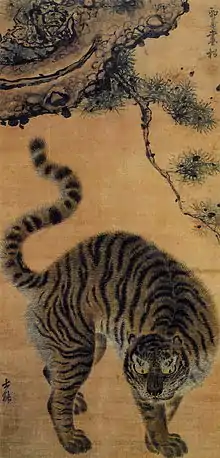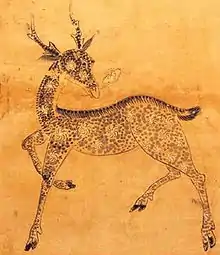Minhwa
Minhwa refers to Korean folk art produced mostly by itinerant or unknown artists without formal training, emulating contemporary trends in fine art for the purpose of everyday use or decoration.[1] The term "minhwa" was coined by Yanagi Muneyoshi.[2]
| Minhwa | |
 This minhwa depicts a tiger, a popular subject in Korean art. | |
| Korean name | |
|---|---|
| Hangul | 민화 |
| Hanja | 民畵 |
| Revised Romanization | Minhwa |
| McCune–Reischauer | Minhwa |
Minhwa literally means "painting of the people" or "popular painting". This type of painting was often the work of anonymous craftsmen who faithfully adhered to the styles, canons and genres inherited from the past. Minhwa also involved a magical dimension. They were believed to possess beneficial virtues and to protect the owner and his family from evil forces. They feature popular themes such as cranes, rocks, water, clouds, the sun, moon, pine-trees, tortoises, insects and flowers.
Minhwa art developed into its present form in the seventeenth century. The artists were common people who went from place to place, often following festivals, where they would paint for the locals, fulfilling their commissions on the spot. Important stages in life were also marked by the painting of a minhwa picture. Both common people and nobles would commission these artists.
The paintings worked on a number of levels. They show figures from folk mythology and legends, symbols of happiness, wealth and health, and scenes of everyday life. The most common figures were animals that represented power, such as the tiger, or providential circumstances, such as carp, which represent success. The paintings were done on paper and on canvas.
After a decline during the colonial rule, the art form experienced a short boom until laid low by the Korean War. In the 1980s, though, there was a revival of Minhwa, the interest and popularity of which persists to this day.
Genres
Magpie and tiger
Kkachi horangi (까치호랑이) is a prominent genre of minhwa that depicts magpies and tigers. In kkachi horangi paintings, the tiger, which is intentionally given a ridiculous and stupid appearance (hence its nickname "idiot tiger" 바보호랑이), represents authority and the aristocratic yangban, while the dignified magpie represents the common man. Hence, kkachi horangi paintings of magpies and tigers were a satire of the hierarchical structure of Joseon's feudal society.[3][4]
Flower writing
Munjado (문자도; 文字圖), also known as "flower writing" (꽃글씨; kkotgeulssi), is a genre of minhwa that enjoyed popularity in the 18th and 19th centuries, in which large Chinese characters associated with Confucian philosophy are painted as a representation of their meaning, with depictions of related stories and themes painted into the characters themselves.[1][5]
Chaekgeori
Chaekgeori is a genre of still-life painting that features books as the dominant subject. Originally a court art embraced by the upper class, chaekgeori spread to the minhwa folk art of the common class in the 19th century, resulting in more expressionist and abstract depictions, and the diminished prominence of bookshelves as a primary motif.[6]
Literature
- Korean Tiger: An Exhibition of Korean Folk Painting; To Commemorate the Dedication of the Olympic stadium; Seoul, Sept.29-Oct.14, 1984. Zayong Zo [editor]. Seoul: Emilie Museum, 1984.
- Yoon, Yul Soo, 2005, Minhwa, designhouse.
Gallery
| Wikimedia Commons has media related to Minhwa. |
 Hwanjogujado (picture of puppies and flowers, birds)
Hwanjogujado (picture of puppies and flowers, birds) Cat
Cat Gammo yeojaedo (감모여제도 感慕如在圖)
Gammo yeojaedo (감모여제도 感慕如在圖) Tiger
Tiger Magpie and tiger
Magpie and tiger Ssanghak pandodo, literally "picture of two cranes and peaches in Sungyeong", paradise of Korean Taoism
Ssanghak pandodo, literally "picture of two cranes and peaches in Sungyeong", paradise of Korean Taoism Eohado (picture of fish and crabs)
Eohado (picture of fish and crabs) Chaekgeoli
Chaekgeoli Hwajodo (flowers and birds)
Hwajodo (flowers and birds) Jangsaeng hwarakdo
Jangsaeng hwarakdo Munjado
Munjado Munjado
Munjado
References
- Korean Culture and Information Service (2011). Korean Beauty. 길잡이미디어. p. 272. ISBN 9788973751204. Retrieved 3 December 2017.
- "민화". Encyclopedia of Korean Folk Culture. National Folk Museum of Korea. Retrieved 15 September 2018.
- "까치호랑이". Encyclopedia of Korean Folk Culture. National Folk Museum of Korea. Retrieved 1 December 2017.
- KOREA Magazine March 2017. Korean Culture and Information Service. 2017. Retrieved 1 December 2017.
- "효제문자도". Encyclopedia of Korean Folk Culture. National Folk Museum of Korea. Retrieved 3 December 2017.
- "책거리". Encyclopedia of Korean Folk Culture. National Folk Museum of Korea. Retrieved 30 November 2017.
